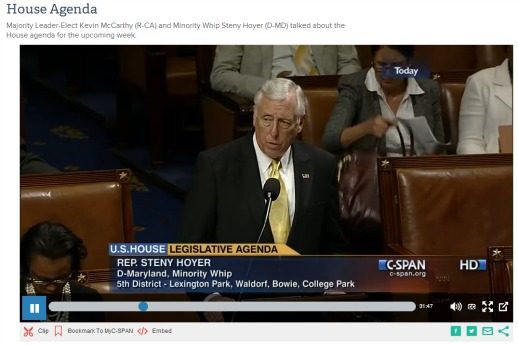C-SPAN Moving to Authenticated TV Ch. Streaming

C-SPAN is launching a beta test of its migration of live online feeds of its TV channels—C-SPAN 1,2,3—to an authentication model starting Monday, employing the TV Everywhere model of the MVPD's who support the public affairs channel .
C-SPAN added a note on its Web site that "Online access to these three TV channels will soon require registration. Learn more." It won't require authentication Monday, but it will be an option so folks can start getting used to the idea and be signed-up and ready for the switch.
The "soon" is sometime in late summer. The "more" is that "online, live access to C-SPAN's three television channels will be available only to verified customers of C-SPAN's cable and satellite TV affiliates," says Susan Swain, C-SPAN co-CEO in a video explaining the change.
C-SPAN will continue to provide on the Web site live coverage, free of charge and ads, and in the clear of House and Senate floor proceedings, committee meetings, White House press conferences, the courts, elections, and coverage of agency proceedings—FCC meetings, for example—and all other government activities.
In addition, C-SPAN-produced programing on those TV channels will also be available to all Web users on demand in the C-SPAN video library of over 200,000 hours of content and growing. Essentially all the programming will still be available free online to everyone, just not aggregated in the form of the live, linear TV channels.
What is beginning Monday is that those who want to stream the live feeds of the TV channels will be asked to enter their cable or satellite provider credentials to access that stream. For the transition period—until later in the summer, the channels will still be available even without that sign-in, but authenticated users will get it at a better bit rate as C-SPAN transitions those channels. "We wanted to increase the bit rate for the TV channels so that those authenticated viewers could have a more TV-like experience," said co-CEO Rob Kennedy, while continuing to stream the channels in parallel at the current bit rate during the transition, which will allow those users time to transition, he added.
And why authenticate? Swain points out that while C-SPAN covers the government, it is not government-sponsored. It is a private nonprofit whose ability to deliver that content depends on license fees from its cable and satellite affiliate partners.
Broadcasting & Cable Newsletter
The smarter way to stay on top of broadcasting and cable industry. Sign up below
"Reserving online access to our three television channels to cable and satellite customers reflects the dynamic changes you can see going on in video distribution today," she says, and important to preserving the business model for the future.
"Requiring verification for the live feeds of our three cable channels reserves these channels for customers who are supporting them through their monthly cable or satellite bills," says the Web site in an FAQ. "Over time, this policy will enhance what we can provide the general public overall, and helps preserve the important public service mission which guides all C-SPAN operations."
Contributing editor John Eggerton has been an editor and/or writer on media regulation, legislation and policy for over four decades, including covering the FCC, FTC, Congress, the major media trade associations, and the federal courts. In addition to Multichannel News and Broadcasting + Cable, his work has appeared in Radio World, TV Technology, TV Fax, This Week in Consumer Electronics, Variety and the Encyclopedia Britannica.










